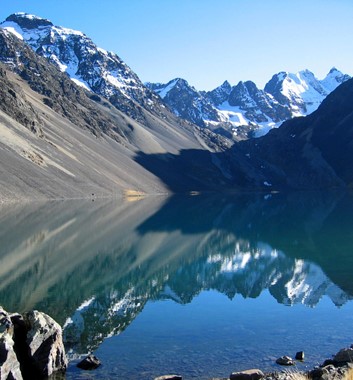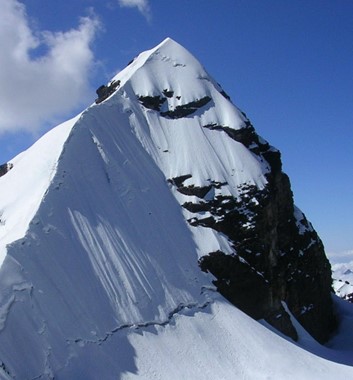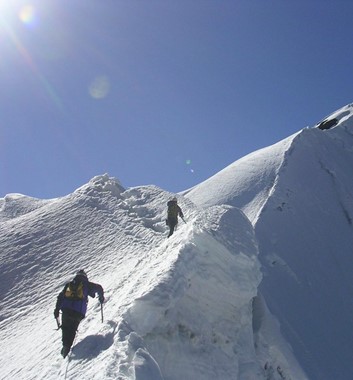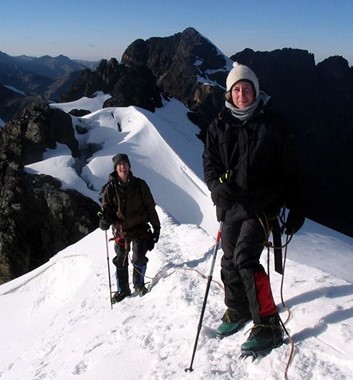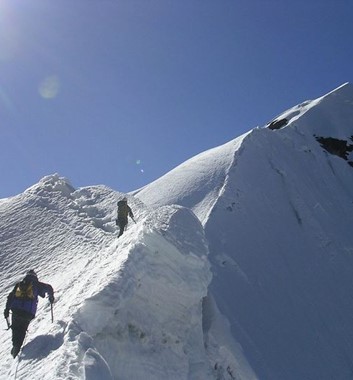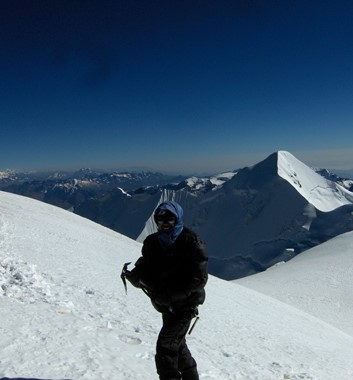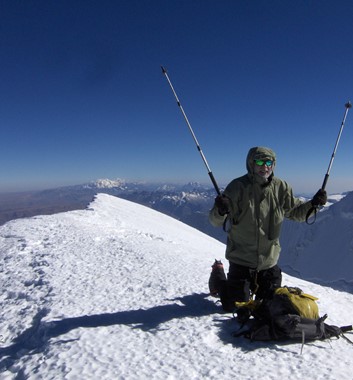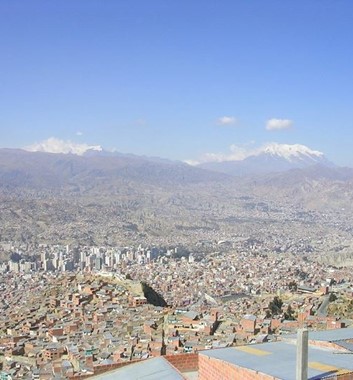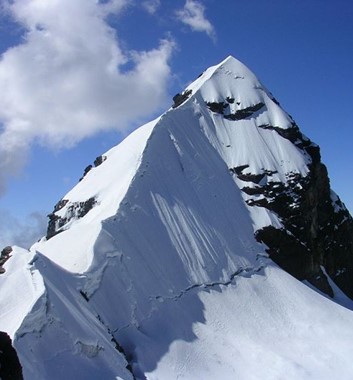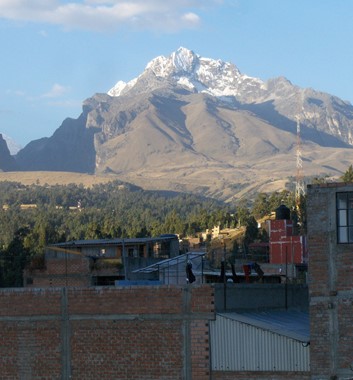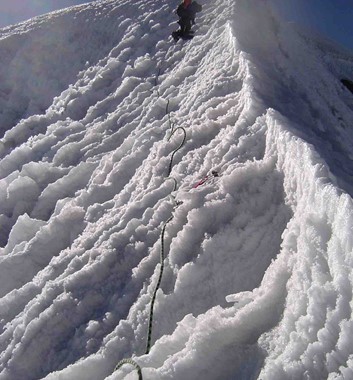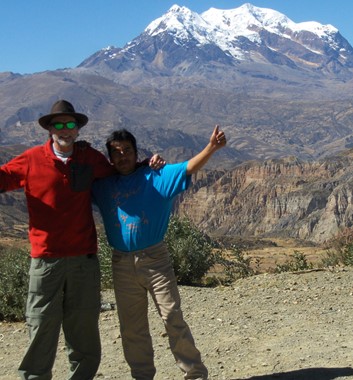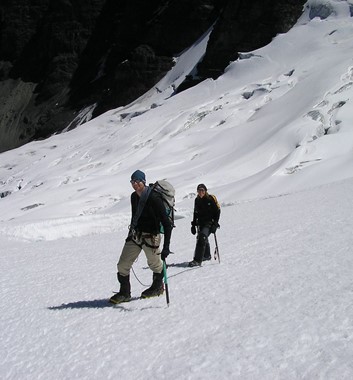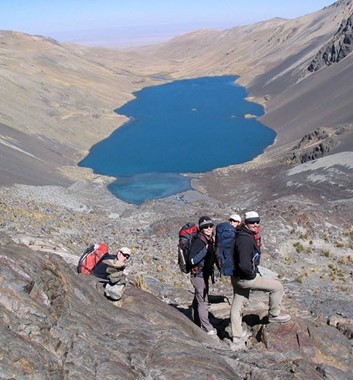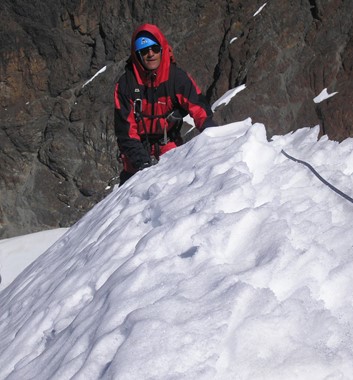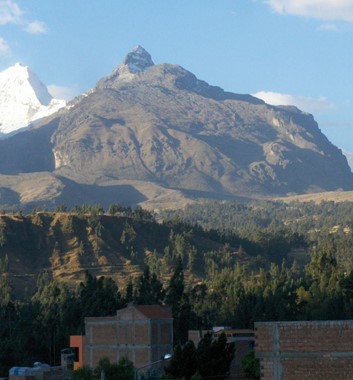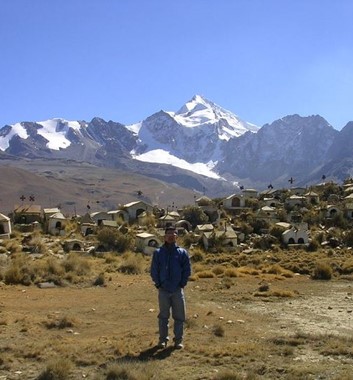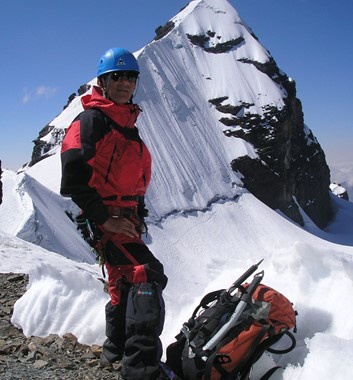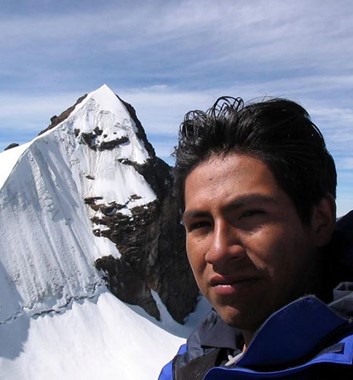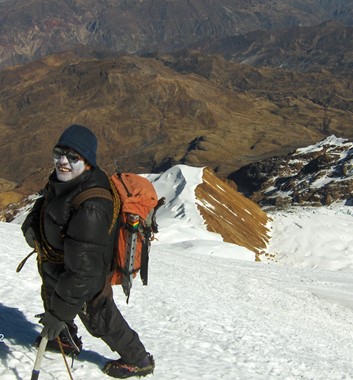Overview
This trip is a superb introduction to mountaineering in Latin America. We tackle two peaks that are both respectable and popular mountaineering objectives, plus the option to climb a harder peak called Illimani for an additional week in Bolivia. It is quite a strenuous trip demanding fitness and experience camping outdoors, however we will be using mules and some base camp facilities along the way. There will always be one guide to three clients when climbing on the rope.
The climbing averages PD+/AD (Scottish II) and does require confidence, experience on snow and ice and knowledgable use of crampons and ice axe. It is also required that members have experience of roped travel on glaciated terrain and steep ground. We will be asking applicants to send us some details of their climbing experience before acceptance onto this trip.
We fly in to La Paz in Bolivia at 4000m but we do recommend that if you have time you may wish to arrive even earlier to get used to the altitude. It is definitely a very high starting point for a mountain trip.
Start point La Paz (3627m) surrounded by glaciated peaks and rolling hills. Minimum two days acclimatising and visiting Lake Titicaca and the reed islands.
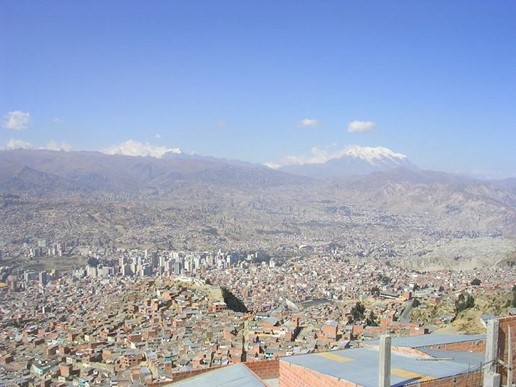
Pequeno Alpamayo (17,482 feet/ 5329m) climb is technical yet reasonable (AD). Ideal place to increase your mountaineering skills. 5 days practicing glacier and climbing skills, acclimatizing, climbing sub-peaks, and finally making our summit bid. The summit day consists of a moderate glacier, followed by two pitches of fourth class rock, and then steep ice or neve on a knife-edged ridge. After our team makes its summit bid, we will trek onto the next peak.
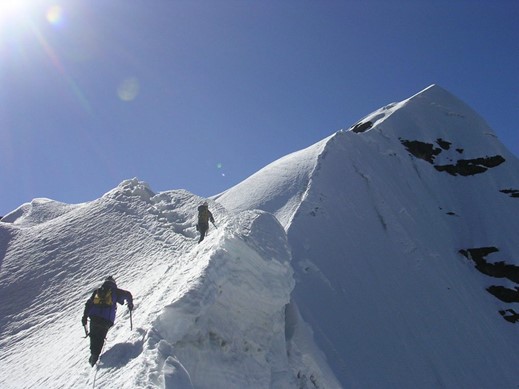
Huayna Potosi (19,975 feet 6088m, AD) is a short drive from La Paz to the base camp. Spend a day practicing steeper ice climbing skills on the glacier’s edge. Summit day route is comprised of steep glacier travel and a final airy ridge to the summit. A summit of Huayna is excellent preparation for longer routes on the big mountains of the world.
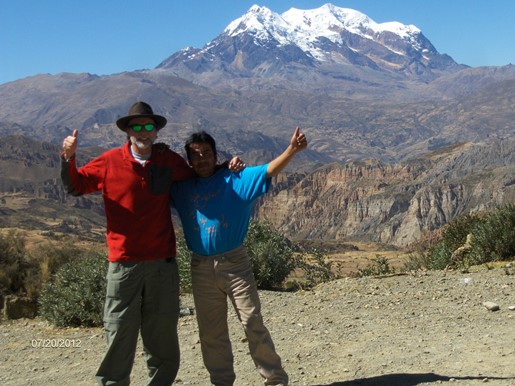
Optional third peak of Illimani (21,125 feet/6,439 meters), tallest in the Cordillera Real and graded a PD climb. After a beautiful approach through Bolivian farmland and small indigenous towns, arrive at base camp and move to high camp known as Nido de Condores at 18,372 feet (5,600 meters). Summit day takes us across an exposed ridge and then onto broad snow slopes, around crevasse fields, and eventually onto the final, classic, knife-edged summit ridge which can involve 55° ice climbing at an altitude of nearly 6,000m.
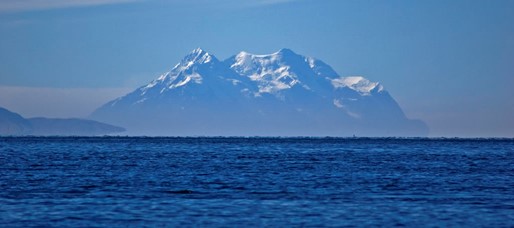
Huayna Potosi and Pequeno Alpamayo itinerary
The main trip is 15 days in-country. Add a day at either end for flights which will make it 17 days in total. However feel free to arrive a day or so early or leave a day or so later.
If you would like to climb Illimani as well then the trip is 21 days in country, or 23 days with flight time.
| Trip day | Programme |
| 1 | Arrive La Paz, Explore city, relax, acclimatise. 3650m |
| 2 | Visit Tihuanaco, travel to Copacabana. 3800m |
| 3 | Visit Island of the Sun, lake Titicaca. 3800m |
| 4 | Drive out to Cordillera Real, Trek to Ajuani camp. 4300m |
| 5 | Trek via 4800m pass to Juri Khota Lake camp, 4300m |
| 6 | Trek via Austrian Pass, 5100m up to Pico Austria at 5250, and down to Condoriri Valley camp at 4600m |
| 7 | Glacier skills training close to Condoriri Valley camp. 4600m |
| 8 | Summit day Pequeno Alpamayo. 5350m |
| 9 | Spare day |
| 10 | Trek to Maria Lloco camp. 4500m |
| 11 | Trek to Huayna Base camp. 4700m |
| 12 | Climb to Huayna High camp. 5250m |
| 13 | Summit day Huayna Potosi. 6088m. |
| 14 | Spare day |
| 15 | La Paz, depart for home or stay for next climb |
| 16 | Illimani group drive to Pinaya and walk to Base Camp of Illimani at 4400m. |
| 17 | Move to high camp Nido de Condores, 5400m. |
| 18 | Summit day, 6439m and returning to base camp |
| 19 | Spare day |
| 20 | Returning to base camp and La Paz |
| 21 | La Paz, depart for home or stay |
How fit do I have to be to climb Huayna Potosi and Pequeno Alpamayo?
This trip can be quite physically strenuous. This is mainly due to the effects of altitude, which exaggerate the exertion required during the trek and climbs. As this area of Bolivia is all at high altitude we are not able to work up from lower elevations.
We will land on our international flight into La Paz at close to 4000m, in most other locations you would try to take around a week working up to this altitude in stages. Therefore we spend the first few days of the trip visiting areas such as Lake Titicaca on a relaxed routine in order to help our bodies adjust to the altitude.
On the trek and climbs it will again be largely the effects of altitude that will dictate perceived difficulty, as we will move very slowly and steadily. However, it will be important to arrive on this trip in good physical shape and also healthy and determined.
The type of fitness you need to build up will focus on low-intensity but sustained cardio-vascular exercise. 4-6 hour walks with a light back-pack are ideal preparation. Swimming, cycling and yoga are also great ways to build up the right kind of fitness whilst minimising risks of injury. You may also chose to target some strength training on your upper legs, calves and back.
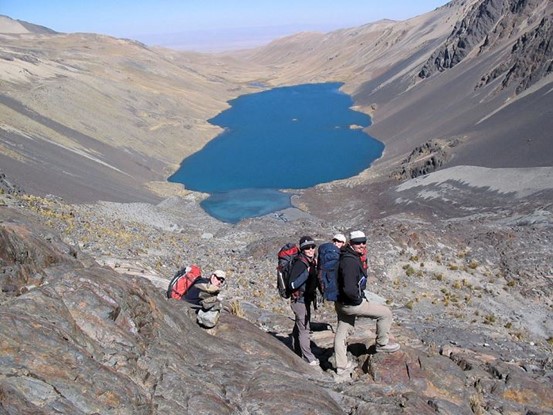
The trek follows established routes, though through rugged and remote terrain. It will be necessary to wear supportive trekking boots to protect your ankles.
The climbs ascend snow and ice slopes which are moderate in general but steepening considerably on the upper reaches, up to approx 55 degrees. Parts of the upper mountain also require careful traversing of snow ridges and steep aretes with some considerable exposure to large drops. This will all be protected where required but will require careful axe and crampon work. Training and skills refreshers in the necessary techniques will be given. However, care and a head for exposed drops will be essential.
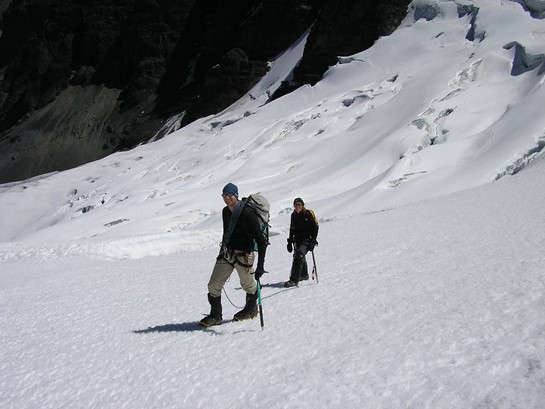
Grading of the routes depends of course on the prevailing weather and snow conditions, however, a commonly accepted alpine grade for Huayna Potosi would be (PD/AD-) and for Pequeno Alpamayo (AD). Illimani is AD.
Previous experience of rock scrambling or climbing and use of crampons and ice axe on steep terrain are therefore considered essential for your enjoyment and safety of this trip. For more information on high-altitude peaks, click here.
Huayna Potosi and Pequeno Alpamayo kit list
- BAGS - Large rucksack + daypack ~45L, dry bags
- SHELL - Top and bottoms
- INSULATION - fleece layers, gloves, mitts, light down top, warm hat, buff, base layers
- TREKKING CLOTHES - shorts, shirts, trousers, sunhat
- FEET - Trekking boots, mountaineering double-boots or hybrids, sandals, trekking and climbing socks, gaiters
- SLEEPING - Warm sleeping bag rated to -15C and sleeping mat
- EATING/DRINKING - Water bottles, snacks, insulated cup, bowl and fork/spoon/knife
- WASHING & MEDICAL kit plus suncream and UV lip salve
- CLIMBING - Crampons, ice axe, harness, at least one sling, 2 karabiners (locking), 2 karabiners (snap), prussik, helmet
- EXTRA - Walking poles, sunglasses/goggles, camera/phone/charger, headtorch, repair kit, personal kit
Adventure Alternative will supply the climbing ropes, tents and cooking equipment.
A lot of this equipment can be rented in La Paz or also from our rental outfit in the UK, however we would assume that people on this type of expedition will already have this equipment and clothing and be self-sufficient and experienced in its use. For more information about packing, see our detailed kit list.
Maps and routes
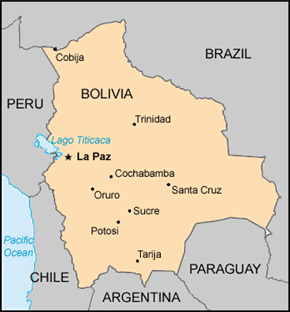
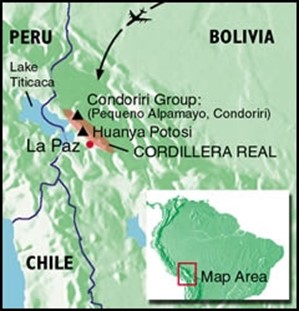
Bolivia is landlocked and almost halfway down South America on the western side of the continent. The main airport to fly to for mountain climbing is La Paz. From this high city the range of Cordillera Real run in a line to the north east of the city. On this map Illimani is slightly south east of the city.
Pequeno Alpamayo route map
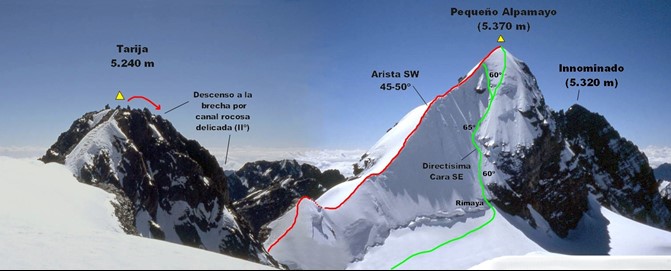
Huayna Potosi route map
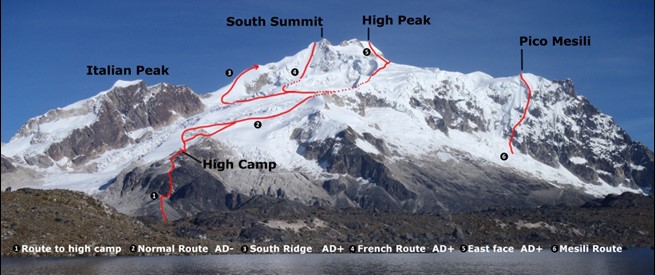
Illimani route map
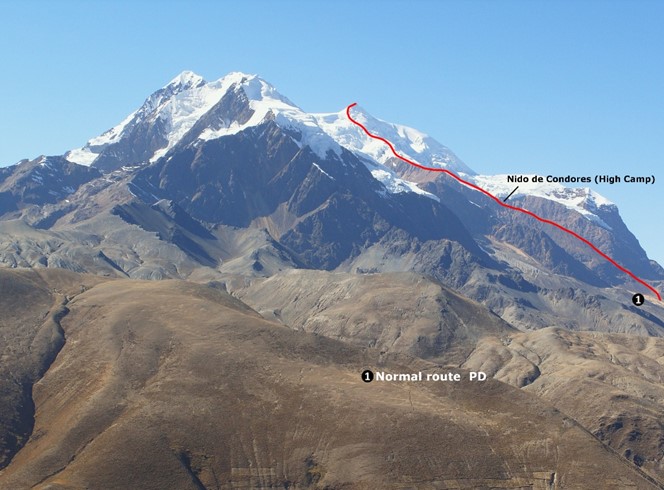
Why climb with us in Bolivia?
- This is an opportunity to experience travel, trekking and the summits of two peaks all within one trip. The process of staged acclimitisation allows us to safely combine all these fantastic alements.
- We have a planned ascent profile to manage the fact that La Paz, where we fly to, is already at high altitude. This will help to maximise your rate of acclimitisation to altitude. This not only improves your safety but also your enjoyment of the trip. However, it is a common reason for people feeling sick right at the start of the trip so if you would like to arrive earlier then please let us know.
- The trek is led by safe and experienced UIAGM or MIC mountain guides from the UK and from our partner company in Bolivia.
- Financial security is guaranteed as we are ABTOT bonded.
- We are audited and registered as complying with BS8848, the highest standard for overseas expeditions.
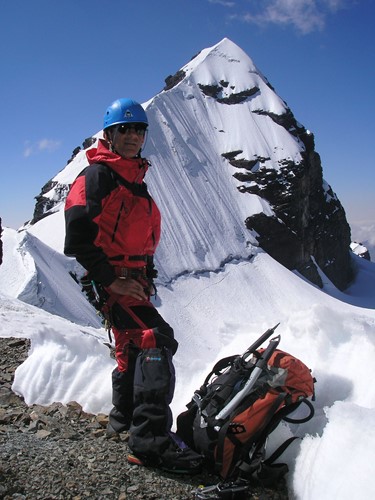
Dates & Bookings
Itinerary
Huayna Potosi and Pequeno Alpamayo itinerary
Flights
The airport in La Paz is called El Alto International Airport. Its code is LPB(IATA) or SLLP(ICAO) It is located 8 mi (13 km) south west of La Paz city. Common routes from the UK are via European and then South American hubs, such as Amsterdam & Lima, Madrid & Santiago, Madrid & Bogota etc
| Day | Elevation | Travel Time | Info |
|---|---|---|---|
| 1 | (4000m)-3650m | Arrive in La Paz at 4000m, transfer to hotel in the heart of the city at 3,650m, it is important to take it gently for the day. There is the chance to visit the attractions of the city, including the notorious Witches Market, colonial museums and perhaps even the coca museum. | |
| 2 | 3800m | Continuing our acclimatisation, we drive out into the altiplano to visit the ancient site of Tihuanaco, an extremely significant pre-Inca civilisation. Continue to Copacabana on the shores of Lake Titicaca (3,800m). | |
| 3 | 3800m | Motor boat onto the Island of the Sun for a three hour trek across the island, enjoying the panorama of the Cordillera Real and Cordillera Apolobamba ranges in the distance. | |
| 4 | 4300m | 2-3 hour drive from Lake Titicaca to Kâotia, where our mules will be waiting. Starting at 4200m, we follow the foothills of the Cordillera Real until we reach the valley of Ajuani. Camp at 4300m | |
| 5 | (4800m)-4300m | Cross two passes of around 4800m before descending into the Juri Khota valley, and camp on the shores of the Lake with the same name (4300m) | |
| 6 | (4900m)-4600m | Cross the Austria pass (5100m) passing magnificent hanging glaciers and glacial lakes before descending into Condoriri valley (4600m) after climbing Pico Austria at 5250m. | |
| 7 | 4600m | A skills practise day today at the base of the glacier. | |
| 8 | 5350m | Summit attempt of Pequeno Alpamayo (5,350m). Departing around 4am, trek to the glacier, first few hours, the gradient remains relatively consistent at around 30 degrees until we reach the saddle of the Tarija peak at 5,300m which is an ideal vantage point to see the final route to the summit of Pequeno Alpamayo (about 1 hour further). The final section is a little steeper (up to 45 degrees) until we reach the summit. Descend the same way. | |
| 9 | 4500m | Spare day. Or break camp and continue our trek along the range, and make our way to the base of Maria Lloco (4,500m). Camp | |
| 10 | 4700m | Trek to Maria Lloco camp or the Huayna base camp at 4,700m. Camp. | |
| 11 | Rest day | ||
| 12 | 5150m | A short trek today to the high camp for acclimatisation and training (5,150m) at the edge of the glacier. Or move to high camp for sleeping. | |
| 13 | 6088m | Early start (around 1am) to aim to reach the summit for sunrise. We step onto the glacier almost immediately, with the majority of the route being a glacial walk, with a couple of small crevasses to negotiate. Or camping at high camp for summit next day | |
| 14 | 3650m | Summit day or spare day or return to La Paz | |
| 15 | 3650m | Return to La Paz, depart home or stay |
Cost
Huayna Potosi and Pequeno Alpamayo cost £2695.00
(with the Illimani option - £3465.00)
INCLUDES
- Professional Bolivian or UK guides (English speaking), ratio up to 1:3 maximum
- Meals during the trek and climb
- Mules and mule drivers (max weight 25kgs/person)
- Airport transfers in La Paz
- Internal transport to the mountains
- Boat tour to Island of the Sun/Titicaca and/or acclimatisation hikes outside the city
- National Park Fees
- Accommodation in city hotel prior to and after the climb
- Sleeping tents and group equipment
EXCLUDES
- International flight to La Paz
- Personal costs such as meals and drinks in La Paz, city sightseeing tours
- Travel/climbing insurance
- Bolivian visa if necessary (free for UK citizens)
- Tips
Payments
A deposit of £100 is required on booking to secure your place and we ask that the remaining balance (trip price minus the deposit) is paid in full 6 weeks prior to your departure. It is important that you take out adequate personal insurance for this trip as early as possible.
Insurance
You will need to take out personal travel insurance for the trip. You need to make sure it covers all the trip locations and activities and also cancellation. Your insurance will need to cover climbing to 6088m and emergency evacuation from the Cordillera Real in Bolivia. It is worth notifying the insurer of the names of the peaks (Huayna Potosi and Pequeno Alpamayo) and that you will be climbing on snow and ice using ropes.
You need to buy cover as soon as you book your place on the trip and buy your flights so that if something happens before the trip that means you can’t travel, you will be able to claim the flights and trip cost back.
A few providers that are worth checking are; Campbell Irvine, the BMC, Snowcard, Insure and Go
Photos
Extras

Additional peak of Illimani
This peak at 6439 metres completes the trilogy of probably the most famous peaks in the Cordillera Real, and is semi-technical on steep snow covered terrain. We would like to see a climbing CV before accepting people on this optional peak which adds a further six days to the expedition.
Choose a scheduled date or contact us to set up private dates or a bespoke itinerary. The minimum deposit is £100.00 and the balance is due four weeks before travel.
Brilliant trip, really sound guides, great food - got all 3 peaks done as well as 3 extra - got a day mountain biking on…
Read More Richie Casey- Duration 16 days
- Numbers 4 min
- Altitude 6088m
- Skill level Intermediate (PD+/AD)
- Extra Illimani climb



